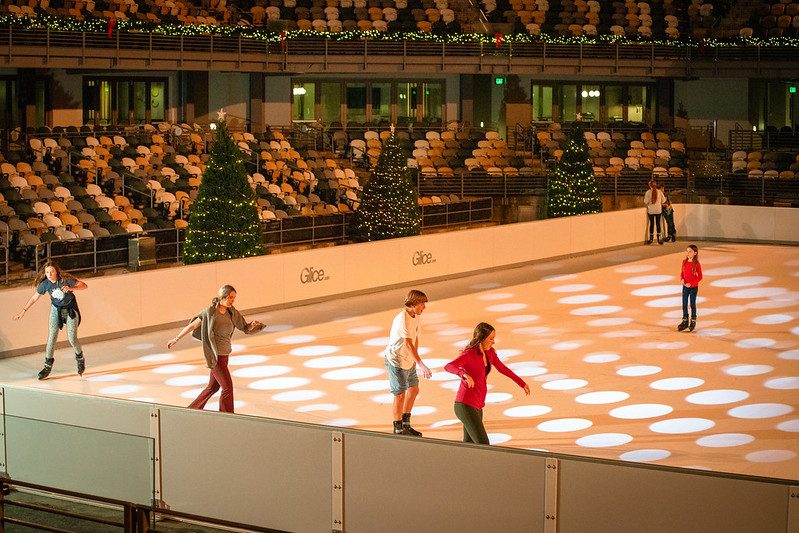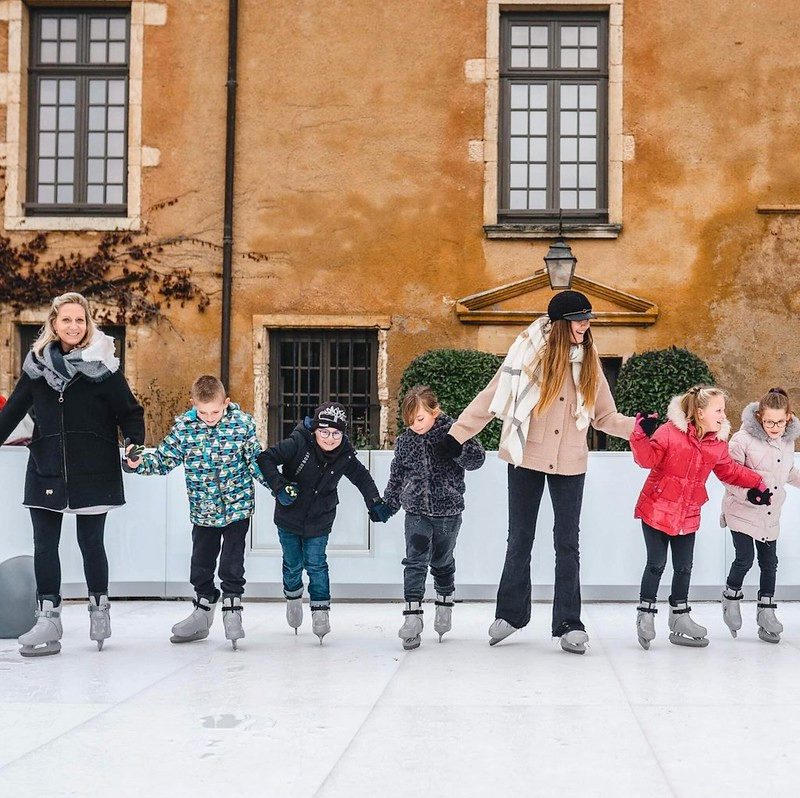Ice skating is universal, attracting people of all ages and backgrounds. Whether it’s a solo skater perfecting their spins or a family enjoying a day out, an ice rink caters to a wide range of individuals. However, traditional ice rinks come with significant environmental and operational challenges.
There are many factors to remember when planning the installation of a successful ice skating rink. Having a business plan is essential to help understand the challenges as well as opportunities. Creating a comprehensive ice rink business plan involves carefully considering costs, operational aspects, financial projections, and marketing strategies. Here are some crucial factors and ideas to help you structure your plan effectively.
Preparing an Ice Rink Business Plan
Before you start with your ice rink business, you should have a strategy for starting, operating, and growing the business. A business plan puts your business idea into writing and serves as a roadmap for entrepreneurs, business owners, investors, and stakeholders. Ensure to provide a clear vision of the business objectives, operations, marketing, financial projections, and overall direction. Taking the time to craft your plan well will help to articulate the business idea, making informed decisions, securing funding, and managing the business effectively.
Introduction to the Ice Rink Business
If you are set on building an ice rink you probably know the basics of ice skating and ice skating rinks. The next steo is to dig deeper:
- What is your business model?
- Which is your target market and which kind of customer segment are you planning to attract?
- What is the growth potential for your rink business?
In the case of an ice skating rink business, there is a wide range of possibilities for usage. They serve as far more than Christmas market attractions and speak to all generations, making them very versatile. Is your rink meant mainly for athletes or will it serve as a leisure activity for the broad masses? These decisions will be essential in the financial planning phase.

Market Research and Analysis
One of the first steps in preparing your business plan is to understand the market and identify the right location for your ice rink. Go more into detail by analyzing demographics and competition. You want to install a rink with a unique selling proposition. To make informed decisions, perform a SWOT analysis (Strengths, Weaknesses, Opportunities, Threats).
To find the perfect spot to open your ice rink, research how many families live in the area. Another consideration is opening close to a big franchise like Starbucks. They carefully choose where to open their stores and their presence results in a lot of traffic for the area.
Also perform research on the market trends to anticipate shifts and create a competitive advantage. A helpful tool to perform the research can be Google Trends. It shows you search volumes for a given keyword and market.
One of the recent trends caused by climate change and rising energy costs is the use of synthetic ice for both public and professional use. The artificial ice surface compares closely to the experience on traditional ice rinks, but it doesn’t need water or electricity. Additionally, the rinks work all year round, regardless of the weather.
Ice Rink Business Model & Operations
In this section, elaborate on details about the ice rink itself. A lot of cost factors need to be taken into account to get a clear vision of the business plan.
- Which surface will you use? Refrigerated ice or synthetic ice?
- Which other facilities are required to operate the ice skating rink?
- What kind of maintenance does the rink need, and which machines will be used?
- How much energy and water will be required to keep the rink working?
- How much staff will you need to operate smoothly?
Financial Projections and Funding
Starting an ice rink business, whether traditional or synthetic, requires a sound financial plan. Analyze the start-up costs and initial investment necessary to start the project. We recommend you elaborate a sales forecast and pricing strategy. Make financial projections for the first 3-5 years of your business. Also, include your financial strategies and funding options in this section. This part is essential to set the foundation for a financially viable venture.
Startup costs for an electricity-powered ice rink, for instance, significantly outweigh those associated with a synthetic ice rink. Furthermore, while a synthetic ice rink practically eliminates ongoing maintenance expenses, traditional ice rinks tend to accumulate substantial long-term costs.
In terms of funding, reaching out to the local government is a viable option, and you can also consider using dasher boards to display advertisements for sponsors.
The primary revenue stream is likely to come from selling entrance tickets. To bolster your earnings, you can offer services such as skate rentals and skating lessons. Exploring opportunities like event hosting, such as birthday parties, can further contribute to your income. Additionally, providing food and beverage options can serve as both a source of revenue and an enticing feature to attract potential customers. Additionally, Merchandising can be a great way to increase revenue and attract attention to your rink!

Marketing and Sales Strategy
To thrive in the competitive market, a robust marketing and sales strategy is essential:
- Think about branding and positioning
- Which are your marketing channels and strategies for your ice rink?
- How will you acquire customers?
- How can partnerships and promotional activities drive sales?
Once more, consider what can set your rink apart and how to effectively market your Unique Selling Proposition (USP). Creating a warm and inviting atmosphere where customers want to spend more time, having winterly drinks etc., is key.
Risk Assessment and Management
Running a business involves risks, and you should take into consideration potential risks associated with an ice rink business. Offering risk mitigation strategies and contingency plans ensures a resilient and adaptive business model.
It’s crucial to stay abreast of the current shifts in the winter sports industry and embrace innovative solutions such as synthetic ice. These measures not only enhance the business’s sustainability but also make it more resilient in the face of changing climates. By adapting to these developments, your ice rink can remain relevant and be a key driver of long-term success and resilience in your ice rink business.
Sustainable Practices and Community Engagement
Emphasize the significance of sustainable initiatives and community involvement, demonstrating our commitment to environmental responsibility and nurturing a sense of belonging within the community. Synthetic ice stands out as a more environmentally conscientious alternative compared to conventional refrigerated ice rinks. By aligning our business with these sustainable practices, we not only reduce our environmental footprint but also cultivate a stronger bond with the local community.

Helpful Resources for Cost Calculations and Examples
Initial costs
To provide accurate costs for an ice rink, many factors need to be considered. For a traditional ice rink you will need: foundation, piping/insulation, compressors and controls, dasher boards, and a Zamboni. Just the Zamboni, which is essential for smooth skating, is a significant cost factor, starting at around $10,000. For the installation of a 200 m² rink ( 2100 ft²) , you could be looking at costs roughly ranging from €100,000 to €120,000 ($108,000 – $129,000) or more. This includes just the cost of the actual rink, no permanent structure, roofing or building.
All that is needed to run a Glice Eco Ice Rink of the same size are the synthetic ice panels to cover the surface, and possibly some dasher boards. The estimated cost is €65,000 ($70,000), which is almost half the cost of a traditional rink. Adding all needed maintenance equipment, as well as skates and anything relevant for ice skating, the purchase price is still under €100,000 ($108,000).
Long term costs
Refrigerated Ice Rink
Calculating the annual electricity cost for a 200 m² real ice rink can be complex and depends on several factors, including the efficiency of the refrigeration system, the local electricity rates, the climate of the region, and how often the ice rink is in operation. For a refrigerated ice rink, these are some of the factors for long term costs to include in your calculation:
- Power for compressors
- Water for ice making
- Refrigerant reloads
- General maintenance
- Resurfacing
- Humidity controls and air conditioning
- administrative and operational labor
You will also need to factor in the following specifications:
Refrigeration System Efficiency
The energy usage of the refrigeration system is a significant factor. Ice rinks typically use a chiller system to maintain the ice. The efficiency of this system, measured in kilowatts per hour (kW/hr) per ton of cooling, will affect electricity consumption.
Operating Hours
The number of hours the ice rink is operational each day and the number of operational days in a year are crucial. Typically, ice rinks are open for several months, but the actual hours of operation may vary.
Local Electricity Rates
The cost of electricity in your area, usually measured in cents or pence per kilowatt-hour (kWh), will influence the annual electricity cost.
Synthetic Ice Rink
For the long run cost of a synthetic ice rink, the cost factors that need to be taken into account are maintenance and cleaning as well as labor.
Generally, the maintenance costs of a synthetic ice by Glice are less than 51% compared to a conventional ice rink.
Tips for Success
Success in the ice rink business lies in excellent customer service. Diversify offerings to attract different customer segments, for example, by planning various events related to ice skating. Work on continuous improvement and adapting to the market trends. Here are some additional tips when creating your ice skating rink business.
Cost Considerations:
- Evaluate the initial cost difference between traditional ice and synthetic ice.
- Consider long-term cost savings associated with maintenance and energy.
- Explore financing options and potential grants for eco-friendly initiatives.
Operational Considerations:
- Develop a maintenance schedule for the ice to ensure longevity and performance.
- Implement safety protocols for skaters using synthetic ice.
- Consider partnerships with local businesses to offer combined services (e.g., skate rentals, and lessons).
Marketing and Sales Strategies:
- Leverage social media and online advertising to reach a wider audience.
- Offer promotional packages for group events, parties, or lessons.
- Establish loyalty programs to encourage repeat visits.
Community Engagement:
- Host community events or open houses to introduce the ice rink to the public.
- Collaborate with local schools or organizations to promote ice sports and activities.
- Offer discounted rates for residents or community groups.
Sustainable Practices:
- Use eco-friendly materials for the ice installation.
- Incorporate energy-saving practices into the rink’s daily operations.
- Evaluate the benefits of both traditional and synthetic ice regarding sustainability and other factors.
- If you decide to use synthetic ice, educate customers on the environmental benefits of using it.
Tips for Success:
- Build the rink in an easily accessible, highly-trafficked location
- Regularly solicit customer feedback and adapt the business accordingly.
- Stay informed about emerging trends and technologies in the ice rink industry.
- Build a strong online presence to attract a broader customer base.

Conclusion
In conclusion, the ice rink business is an exciting venture with immense potential for success. By embracing synthetic ice and aligning with sustainable practices, we aim to create a space that not only entertains but also contributes positively to the environment. With a well-structured business plan and a commitment to excellence, we’re poised for a successful and fulfilling journey in the ice rink industry.
If you are interested in finding out more about synthetic ice and its benefits, contact our team. You will be advised by a local staff member who will happily help you along with all the above steps to make your project the most successful! If you’re not ready to get in touch, consider reading our more specific article on how to develop a synthetic ice business plan.





